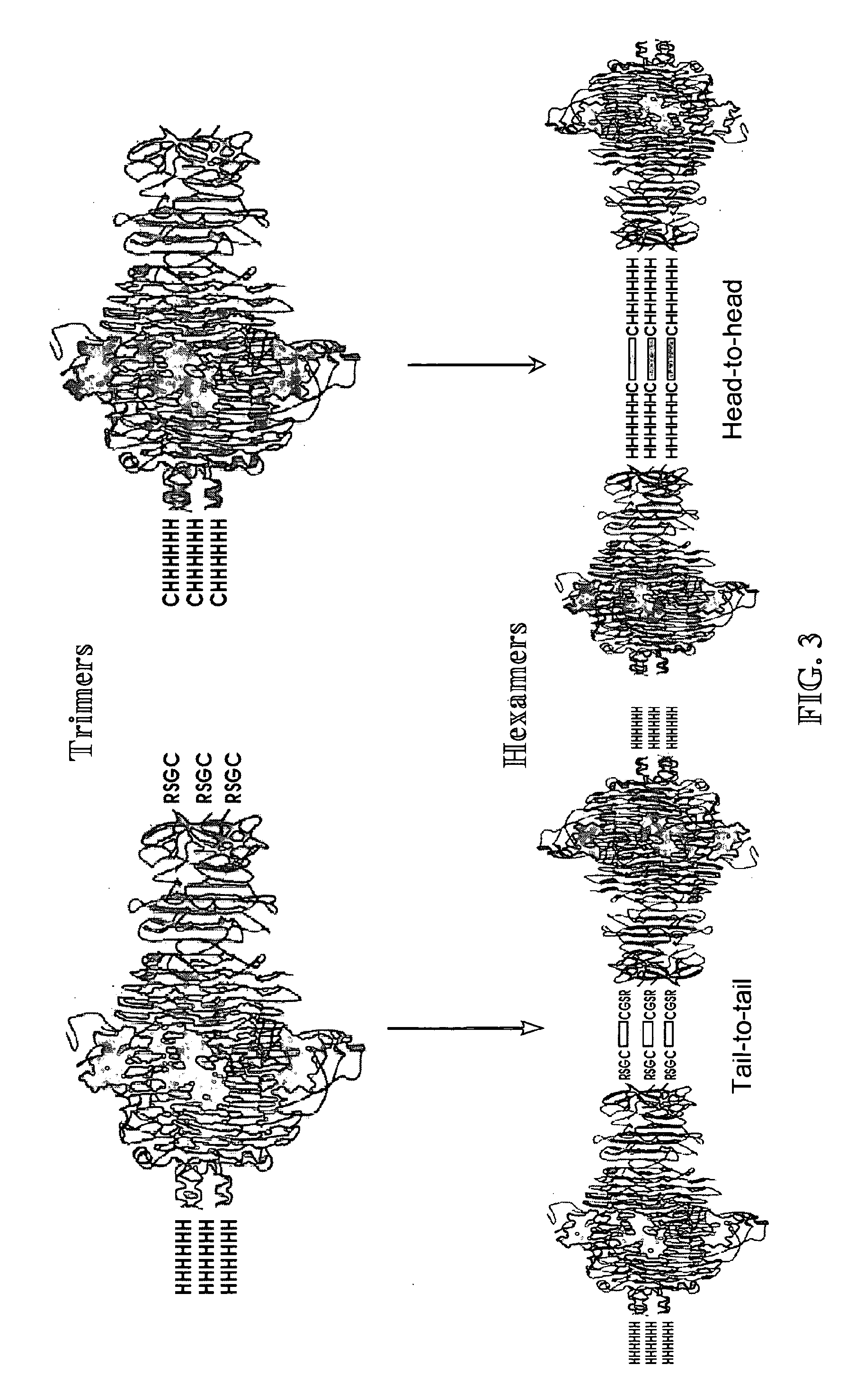Phage receptor binding proteins for antibacterial therapy and other novel uses
a technology of phage receptor and binding protein, which is applied in the direction of antibacterial agents, peptide/protein ingredients, peptide sources, etc., can solve the problems of millions of infections, tens of thousands of hospitalizations, hundreds of deaths, etc., and achieve the effect of facilitating infection
- Summary
- Abstract
- Description
- Claims
- Application Information
AI Technical Summary
Benefits of technology
Problems solved by technology
Method used
Image
Examples
example 1
Methods for TSP Characterization
Materials and Methods
[0158]Salmonella typhimurium (ATCC19585), Staphylococcus aureus (ATCC12598) and P22 phage (ATCC19585-B1) were purchased from American Type Culture Collection (Manassas, VA.). pET1 la expression vector and E. colI strain BL21(DE3) (expression host) were purchased from Novagen (Madison, Wis.).
1.1 Cloning and Expression of P22sTsps
[0159]Truncated versions of P22 phage tail spike gene lacking the codons for the first 108 amino acids (P22sTsp) were generated by a standard PCR using the phage P22 genome as the template. The primers incorporated Nde I and Bgl II sites as well as N- or C-terminal His6 tags. The PCR products were cloned into pET11a vector followed by transformation in the E. coli strain BL21(DE3), using standard cloning techniques. Positive clones were identified by colony PCR and DNA sequencing.
[0160]The enzyme mutants P22sTsp5−x (SEQ ID NO:4) and P22sTspH5−x (SEQ ID NO:2) were constructed by splice overlap extention (SO...
example 2
Methods for Reduction of Colonization of Bacteria in Poultry
2.1 In Vivo Experiments
[0191]One-day-old chicks were arrived, acclimated and tagged on day 1. 10% of the chicks, selected at random, were swabbed cloacally with calcium alginate swabs (Cat. No. 14-959-77, Fisher Scientific, Ottawa, ON, Canada). The swabs were used to streak on XLD plates which were subsequently incubated at 37° C. overnight for determining the presence of endogenous Salmonella. (Following incubation, XLD will appear red / pink with Salmonella as black colonies.) On day 2, 2-day-old chicks were orally gavaged (time 0) with 104-107 Salmonella / 300 μL PBS (see Subsection 1.2 for cell preparation). Chicks were subsequently gavaged with 30 μg / 300 μL of P22sTsp5 (SEQ ID NO:8) at time 1, 18 and 42 h (Protocol 1) or 18, 42 and 66 h (Protocol 2) (FIG. 5A) Oral dose was gavaged by attaching a piece of Nalgene® tubing (Nalge Nunc International Corp, Rochester, N.Y.) with ⅛ ID×¼ OD× 1 / 16 wall to a 1-mL syringe, inserting ...
example 3
[0198]Motility plates (NB plates / 0.4% agar with or without 25 μg / ml filter-sterilized P22sTsp5 trimers) were made the day before their use and left at room temperature. P22sTsp5 (SEQ ID NO:8) and P22sTsp5−x (SEQ ID NO:4) trimers were purified by size exclusion chromatography (Superdex 200™ column, GE Healthcare) using PBS as the equilibration buffer and added to the molten motility media just before pouring them into plates (50° C.). To perform motility assays, Salmonella cells were grown on NB plates overnight at 3TC (16-18 h). They were subsequently suspended in sterile PBS at a cell density of 1 OD600. Employing a 10-μL pipettor, 5 μL of the cells were used to inoculate the centre of the motility plates, lightly piercing the surface of the agar plate with the pipettor tip; the plates were left unmoved until inoculation spots became dried. The plates were incubated up-side up at 37° C.
[0199]At different time points, the dimensions of the Salmonella spreads were measu...
PUM
| Property | Measurement | Unit |
|---|---|---|
| temperatures | aaaaa | aaaaa |
| melting temperature | aaaaa | aaaaa |
| Tm | aaaaa | aaaaa |
Abstract
Description
Claims
Application Information
 Login to View More
Login to View More - R&D
- Intellectual Property
- Life Sciences
- Materials
- Tech Scout
- Unparalleled Data Quality
- Higher Quality Content
- 60% Fewer Hallucinations
Browse by: Latest US Patents, China's latest patents, Technical Efficacy Thesaurus, Application Domain, Technology Topic, Popular Technical Reports.
© 2025 PatSnap. All rights reserved.Legal|Privacy policy|Modern Slavery Act Transparency Statement|Sitemap|About US| Contact US: help@patsnap.com



